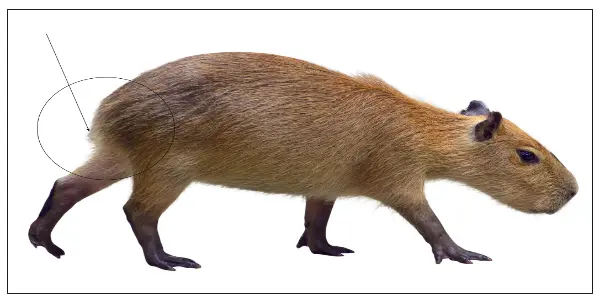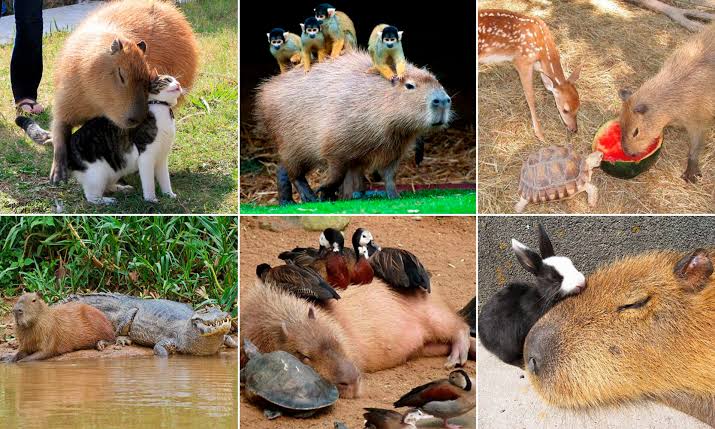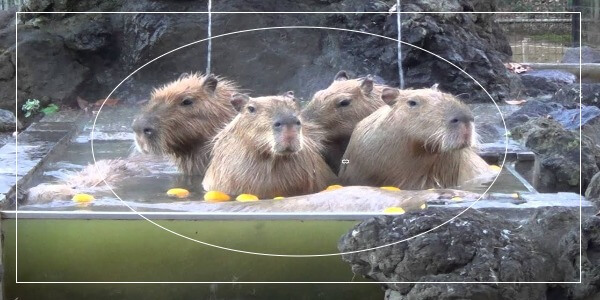Why Don’t Capybaras Have Tails?
Capybaras are known for their unique physical features, such as their webbed feet and long, curved front teeth. One noticeable characteristic that sets them apart from other rodents is the fact that they do not have tails or very short ones.
The lack of a tail in capybaras is not uncommon among the rodent family, as many species of rodents have small tails or no tails at all. However, the absence of a tail in such a large animal like capybaras is still surprising to many people, and it has led to various speculations about why they evolved this way.
There are several theories regarding the evolutionary reasons behind capybaras not having tails. Some scientists suggest that the lack of a tail could be an adaptation to their semi-aquatic lifestyle, as a long tail could be cumbersome and hinder their movements in the water. Others argue that the absence of a tail could be related to thermoregulation, as capybaras live in warm environments and a tail could generate excess heat.
Despite the ongoing debate, the exact reason why capybaras lack tails remains unclear. However, studying this unique physical characteristic can shed light on the biology and ecology of these fascinating animals, and help us better understand their adaptations to their environment.
Understanding the structure and function of capybaras’ bodies, including the absence of a tail.
Capybaras are the largest rodents in the world and have a unique anatomy that allows them to thrive in their semi-aquatic habitats. These animals have stocky, barrel-shaped body that measures up to 1.3 meters in length and can weigh up to 66 kg.
The capybara’s head is round and has small, rounded ears that are set low on the sides. Their eyes are located high on the head, allowing them to keep watch for predators while they swim or forage. Capybaras have large, strong incisors that they use to chew through tough vegetation.
One of the most distinctive features of capybaras is their lack of a tail. Unlike most other rodents, capybaras have only a small stub of a tail that is not visible beneath their fur.
Capybaras have four sturdy, hoof-like toes on their front feet and three on their hind feet. Their legs are short and powerful, enabling them to move easily through the water and navigate the dense vegetation of their habitat.
Capybaras are also known for their thick, coarse fur, which is made up of long, bristly hairs that are specially adapted to repel water and provide insulation. Their skin is tough and has a network of sweat glands, which helps them regulate their body temperature.
Overall, the anatomy of capybaras reflects their semi-aquatic lifestyle, with features that allow them to move efficiently both on land and in the water. Their lack of a tail is just one of the many adaptations that make these fascinating animals unique.
Examining the evolutionary history of capybaras and the reasons why they may have lost their tails over time.
Capybaras are the largest rodents in the world and are native to South America. They have a long evolutionary history that dates back to the late Miocene epoch, around 8 million years ago. Capybaras belong to the family Caviidae, which also includes guinea pigs and rock cavies.
Capybaras are thought to have evolved from a common ancestor with guinea pigs, and their evolutionary history is closely tied to the changing climate and environment of South America. Fossil evidence suggests that capybaras were once much more diverse than they are today, with many different species living in different habitats.
One of the most noticeable features of capybaras is their lack of a tail, or rather, their vestigial tail, which is just a small nub. It’s not entirely clear why capybaras have lost their tails over time, but there are a few theories. One possibility is that their semi-aquatic lifestyle may have played a role, as a tail would create drag and hinder their swimming ability. Additionally, a long tail may have been a liability when fleeing predators, as it could be grabbed and used to slow down or control the capybara.
Another theory is that the loss of the tail is related to the evolution of capybaras’ hind legs. Capybaras have very powerful hind legs, which are used for swimming and running. It’s possible that the loss of the tail was a trade-off for the development of these legs, which are essential for their survival.
Overall, the evolutionary history of capybaras is complex and fascinating, and the reasons for their lack of a tail are likely multifaceted. Regardless of the cause, capybaras have adapted well to their environment and continue to thrive in South America today.
Analyzing the behavior and habitat of capybaras to understand how the absence of a tail may be advantageous or disadvantageous.
Capybaras are found in a variety of aquatic and terrestrial habitats, including swamps, rivers, lakes, and grasslands. They are excellent swimmers and can hold their breath for up to five minutes, which allows them to escape from predators in the water.
Behavior: Capybaras are social animals and live in groups of up to 20 individuals. They are herbivores and feed on grasses, aquatic plants, and reeds. They are most active in the early morning and late afternoon and spend the rest of the day resting in the water.
Absence of tail: Capybaras do not have tails, which is an adaptation to their semi-aquatic lifestyle. In the water, a tail would create drag and make it harder for them to swim. The absence of a tail also allows them to conserve energy, as they don’t have to expend energy to control the movement of their tails.
However, the absence of a tail may also be disadvantageous for capybaras in certain situations. For example, a tail can be used to balance and maintain stability, especially when navigating rough terrain. In addition, tails are often used by animals to signal and communicate with others, and the absence of a tail may limit a capybara’s ability to communicate effectively with other members of its species.
Overall, the absence of a tail in capybaras is a trade-off between the advantages and disadvantages of their semi-aquatic lifestyle. While it makes them more agile in the water, it may limit their ability to communicate and navigate on land.
Comparing capybaras to other animals with and without tails to understand the role that tails play in different species.
Tails are an important feature for many animals, serving a variety of functions. Let’s compare capybaras, which do not have tails, to other animals with and without tails to understand the different roles that tails play in various species.
- Capybaras: As mentioned earlier, capybaras do not have tails. This is an adaptation to their semi-aquatic lifestyle, which requires them to be agile swimmers.
- Cats: Cats have tails that serve multiple functions. They help with balance, especially during jumping and landing. Cats also use their tails to communicate with other cats and as a warning signal when they are feeling threatened or angry.
- Dogs: Dogs also have tails that serve multiple functions. They use them for balance when running and jumping. Dogs also use their tails to communicate with their owners and other dogs. A wagging tail typically signals excitement, while a tucked tail can indicate fear or submission.
- Kangaroos: Kangaroos have tails that are used for balance, just like cats and dogs. However, their tails also serve as a powerful tool for defense. Kangaroos can use their tails to deliver powerful kicks to attackers.
- Monkeys: Monkeys have long, prehensile tails that they can use to grip and hold onto branches. This allows them to move through trees with ease and agility.
In general, tails play important roles in balance, communication, and defense for many animals. In some cases, such as with kangaroos, tails can be used as a powerful tool for self-defense. However, for animals like capybaras, the absence of a tail is an adaptation that allows them to be more efficient swimmers. Overall, the role of tails in different species varies depending on their habitat, lifestyle, and evolutionary history.
The role of predators and defense mechanisms in capybaras and how the absence of a tail may affect their ability to survive.
Predators pose a significant threat to capybaras, as they are a source of food for many carnivorous animals in their ecosystem. In response, capybaras have evolved a number of defense mechanisms to help them survive.
- Group living: Capybaras live in groups of up to 20 individuals, which helps them to spot predators more easily and to fend off attacks together. This is a common strategy among many prey species.
- Vigilance: Capybaras are highly vigilant and will quickly flee when they sense danger. They have excellent hearing and can detect the approach of predators from a distance.
- Hiding: Capybaras will hide in the water when threatened, using their swimming abilities to escape predators.
- Alarm calls: Capybaras make loud alarm calls to alert other members of their group of impending danger.
While the absence of a tail in capybaras may limit their ability to communicate with other members of their group, it is unlikely to have a significant impact on their ability to defend against predators. Capybaras have a number of other defense mechanisms that they can rely on, including vigilance and group living. In addition, the absence of a tail may make capybaras more efficient swimmers, which could help them to escape predators that pursue them into the water.
Lastly, while the absence of a tail may affect capybaras in certain situations, such as when navigating rough terrain, it is unlikely to have a significant impact on their ability to survive in the wild. Capybaras have evolved a range of defense mechanisms that they use to protect themselves from predators, and their semi-aquatic lifestyle has also provided them with adaptations that make them efficient swimmers and allow them to escape danger.
The role of capybara tails in their social and reproductive behavior and how the absence of a tail may affect these processes.
While capybaras are adapted to live without tails, the absence of this feature may have implications for their social and reproductive behavior.
- Communication: Capybaras use a variety of vocalizations and body postures to communicate with each other, and their tails play an important role in this process. For example, a raised tail can indicate dominance or aggression, while a lowered tail can signal submission. The absence of a tail may limit the range of visual signals that capybaras can use to communicate with each other, which could affect their social behavior.
- Scent marking: Capybaras use scent marking to establish territories and to communicate with other members of their group. They have scent glands on their faces and on their backsides, which they use to mark their territories and identify each other. The absence of a tail may make it more difficult for capybaras to apply scent to their surroundings, which could affect their ability to establish and defend their territories.
- Reproduction: Capybaras have a polygynous mating system, in which dominant males mate with multiple females. During mating, males will often grasp onto the female’s tail with their teeth as a means of staying in position. The absence of a tail in capybaras could make it more difficult for males to maintain their grip during mating, which could affect their reproductive success.
So, the absence of a tail in capybaras may have implications for their social and reproductive behavior, particularly in terms of communication and scent marking. While capybaras have evolved other means of communication and marking their territories, the loss of this appendage could still impact their ability to interact with each other. In terms of reproduction, the absence of a tail could affect the mating behavior of capybaras, which could in turn have implications for their reproductive success. However, given the adaptability of capybaras to their environment, it is likely that they have found ways to compensate for the loss of this feature over time.
The implications of the absence of a tail for capybara conservation and management efforts, including captive breeding programs and habitat protection.
The absence of a tail in capybaras may have important implications for conservation and management efforts aimed at protecting these animals in the wild, as well as in captive breeding programs.
- Habitat protection: Capybaras are semi-aquatic animals that require access to water to survive. Habitat loss and fragmentation can therefore have a significant impact on their population numbers. The absence of a tail in capybaras may make it more difficult for them to navigate through dense vegetation and move between habitats. This could make them more vulnerable to habitat loss and fragmentation and could limit their ability to find new areas to establish their territories. As such, habitat protection efforts for capybaras should take into account the challenges they may face due to the absence of a tail.
- Captive breeding programs: Captive breeding programs are an important tool for conserving threatened or endangered species, but the absence of a tail in capybaras may make it more difficult to maintain healthy populations in captivity. For example, the absence of a tail could affect the social and reproductive behavior of captive capybaras, which could in turn impact their breeding success. Captive breeding programs may need to take extra care to provide capybaras with the appropriate social and environmental conditions to compensate for the loss of their tails.
- Conservation planning: The absence of a tail in capybaras may also have implications for conservation planning efforts aimed at protecting this species. For example, conservationists may need to consider the potential impacts of habitat loss and fragmentation on capybaras with shortened tails and may need to identify areas where capybaras can establish territories and breed successfully. In addition, conservationists may need to work to raise awareness about the importance of capybaras and the unique challenges they face due to the absence of a tail, in order to garner support for their protection.
The absence of a tail in capybaras may have important implications for conservation and management efforts aimed at protecting this species in the wild, as well as in captive breeding programs. While the adaptability of capybaras may allow them to compensate for the loss of their tails to some extent, conservationists should still take this feature into account when developing strategies to protect these animals and their habitats.
Conclusion
In conclusion, capybaras are unique animals that have evolved to live without tails, which may have been advantageous in their natural environment. There are several reasons why capybaras do not have tails:
- Aquatic adaptation: Capybaras are semi-aquatic animals that spend a lot of time in the water, and their streamlined body shape and absence of a tail may help them to move more easily through the water.
- Thermoregulation: Capybaras live in hot and humid environments and have developed sweat glands that allow them to cool off in the heat. The absence of a tail may help them to dissipate heat more effectively.
- Predation: Capybaras are preyed upon by a number of predators in their natural habitat. The absence of a tail may make it more difficult for predators to grab onto capybaras and hold onto them.
- Social behavior: Capybaras have evolved other means of communication and marking their territories, such as vocalizations and scent marking. The absence of a tail may limit their range of visual signals, but they have adapted to compensate for this.
- Evolution: Over time, capybaras have evolved to survive and thrive in their environment, and the loss of a tail may have been a gradual process that allowed them to adapt to new conditions.
Overall, while the absence of a tail in capybaras may have implications for their behavior, social interactions, and habitat protection efforts, capybaras have adapted to live without this feature and have developed other means of survival. Their unique physiology and behaviors have made them a fascinating and beloved animal species that continue to thrive in their natural habitat



![How Long Do Capybaras Live? - [Answered] How Long Do Capybaras Live](https://capybaratips.com/wp-content/uploads/2023/03/Capybara-Pix-250x200.webp)





